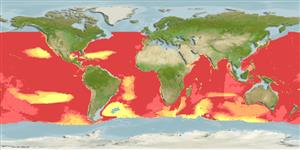Common names from other countries
>
Stomiiformes (Lightfishes and dragonfishes) >
Sternoptychidae (Marine hatchetfishes) > Sternoptychinae
Etymology: Sternoptyx: Greek, sternon = sternon, + Greek, ptyx = fold (Ref. 45335).
Environment: milieu / climate zone / depth range / distribution range
Ökologie
seewasser bathypelagisch; ozeanodrom (Ref. 51243); tiefenbereich 400 - 3676 m (Ref. 26165), usually 500 - 800 m (Ref. 47377). Deep-water; 52°N -
Atlantic, Indian and Pacific: mainly tropical regions (Ref. 47377). Eastern Atlantic: scattered records southwest of Ireland, also from Spain south to Angola. South China Sea and East China Sea (Ref.74511).
Size / Gewicht / Alter
Maturity: Lm ? range ? - ? cm
Max length : 5.5 cm SL Männchen/unbestimmt; (Ref. 47377); max. veröff. Gewicht: 6.90 g (Ref. 126117)
Rückenflossenstacheln (insgesamt): 0; Rückenflossenweichstrahlen (insgesamt): 9-11; Afterflossenstacheln 0; Afterflossenweichstrahlen: 12 - 16. Triangular transparent membrane present above anal fin base (Ref. 13608).
Oceanic and non-vertical migrant (Ref. 4739). Mesopelagic at 275-1200 m (Ref. 58302). Commonly found in 500-800 m both day and night (Ref. 4054). Possibly a cyclic feeder of copepods, ostracods, euphausiids, amphipods, fishes and other taxa (Ref. 4739). Adult photophore complement acquired at 11-13 mm SL (Ref. 4739). Lipid content 1.4 % in fresh body weight and wax ester is 4.2 % in total lipids (Ref. 9193).
Life cycle and mating behavior
Geschlechtsreife | Fortpflanzung | Ablaichen | Eier | Fecundity | Larven
Quéro, J.-C., J.C. Njock and M.M. de la Hoz, 1990. Sternoptychidae. p. 275-282. In J.C. Quero, J.C. Hureau, C. Karrer, A. Post and L. Saldanha (eds.) Check-list of the fishes of the eastern tropical Atlantic (CLOFETA). JNICT, Lisbon; SEI, Paris; and UNESCO, Paris. Vol. 1. (Ref. 4462)
IUCN Rote Liste Status (Ref. 130435)
CITES (Ref. 128078)
Not Evaluated
Bedrohung für Menschen
Harmless
Nutzung durch Menschen
Fischereien: nicht kommerziell
Mehr Information
NamenSynonymeMetabolismusRäuberÖkotoxikologieFortpflanzungGeschlechtsreifeAblaichenFecundityEierEientwicklung
PartnerBilderStamps, Coins Misc.LauteCiguateraGeschwindigkeitSchwimmstilKiemenoberflächeOtolithsGehirngrößeSehfähigkeit
Tools
Zusatzinformationen
Download XML
Internet Quellen
Estimates based on models
Preferred temperature (Ref.
115969): 2.4 - 10.4, mean 6.8 (based on 1057 cells).
Phylogenetic diversity index (Ref.
82804): PD
50 = 0.5625 [Uniqueness, from 0.5 = low to 2.0 = high].
Bayesian length-weight: a=0.03467 (0.02139 - 0.05620), b=2.96 (2.82 - 3.10), in cm Total Length, based on LWR estimates for this species & (Sub)family-body (Ref.
93245).
Trophic level (Ref.
69278): 3.4 ±0.2 se; based on diet studies.
Widerstandsfähigkeit (Ref.
120179): mittel, Verdopplung der Population dauert 1,4 - 4,4 Jahre. (Assuming tmax>3).
Fishing Vulnerability (Ref.
59153): Low vulnerability (10 of 100).
